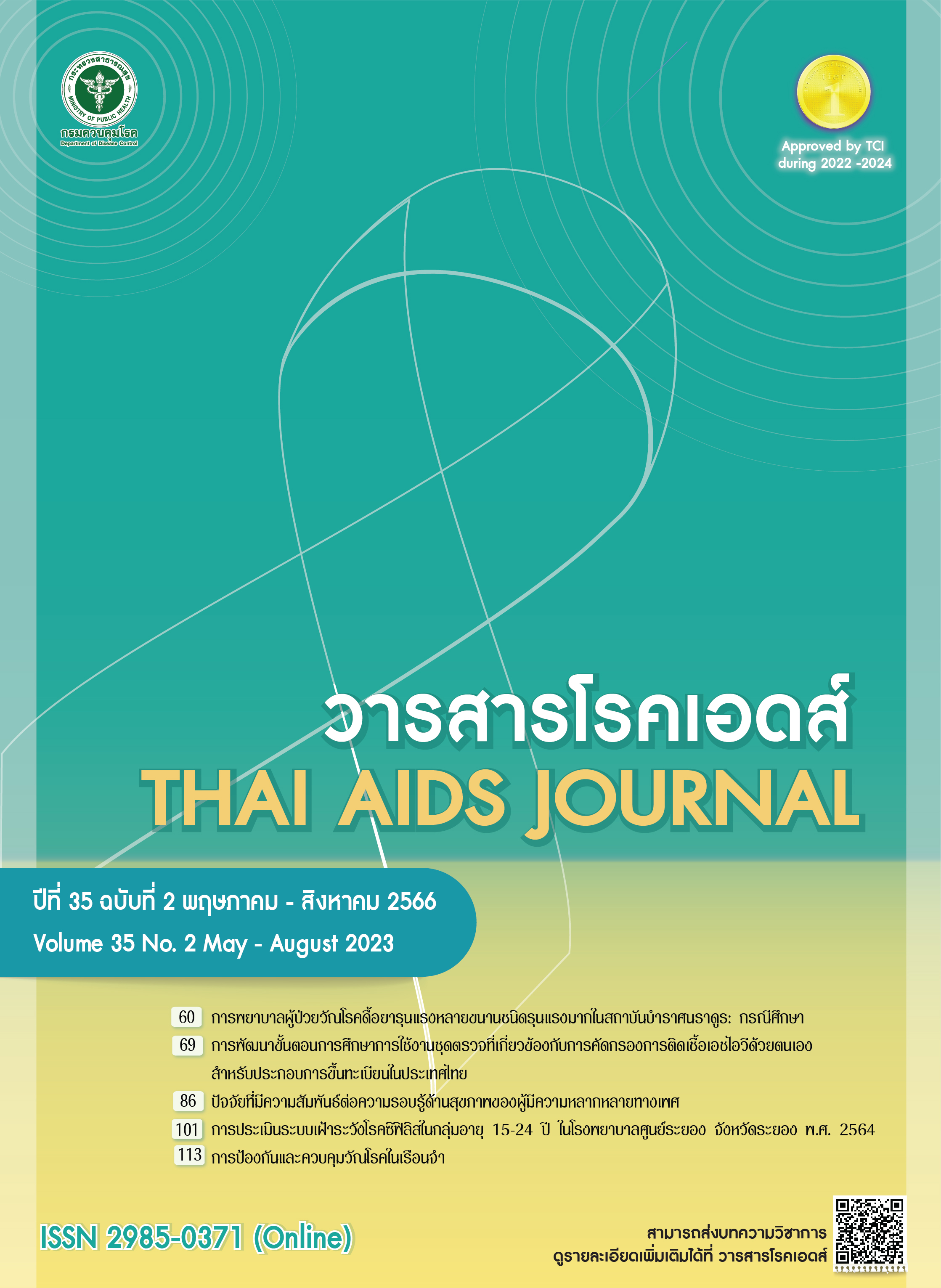ปัจจัยที่มีความสัมพันธ์ต่อความรอบรู้ด้านสุขภาพของผู้มีความหลากหลายทางเพศ
DOI:
https://doi.org/10.14456/taj.2023.8คำสำคัญ:
ความรอบรู้ด้านสุขภาพ, ผู้มีความหลากหลายทางเพศ, อัตลักษณ์ทางเพศบทคัดย่อ
บทความนี้มีวัตถุประสงค์เพื่อศึกษาปัจจัยที่มีความสัมพันธ์กับความรอบรู้ด้านสุขภาพของผู้มีความหลากหลายทางเพศ โดยใช้ข้อมูลทุติยภูมิจากโครงการพัฒนารูปแบบการสร้างเสริมความรอบรู้ด้านสุขภาพในกลุ่มผู้มีความหลากหลายทางเพศ เก็บข้อมูลในช่วงเดือนกันยายน-ตุลาคม พ.ศ. 2563 จำนวน 454 คน ใช้ระเบียบวิธีวิจัยเชิงปริมาณ วิเคราะห์ข้อมูลด้วยสถิติเชิงพรรณนาและการวิเคราะห์ถดถอยเชิงเส้น ผลการวิจัย พบว่า ระดับการศึกษา อัตลักษณ์ทางเพศ และการมีกลุ่มเพื่อน มีความสัมพันธ์กับความรอบรู้ด้านสุขภาพในประเด็นความหลากหลายทางเพศ โดยผู้ที่สำเร็จการศึกษาปริญญาตรีมีความรอบรู้ด้านสุขภาพน้อยกว่าผู้ที่สำเร็จการศึกษาสูงกว่าปริญญาตรี (p<0.05) และผู้ที่เป็นทอมหรือชายข้ามเพศมีความรอบรู้ด้านสุขภาพน้อยกว่าเกย์ (p<0.05) และผู้ที่เป็นสาวประเภทสอง/กะเทย/หญิงข้ามเพศ มีความรอบรู้ด้านสุขภาพมากกว่าเกย์ (p<0.05) นอกจากนี้ผู้ที่มีกลุ่มเพื่อนเฉพาะผู้ที่มีความหลากหลายทางเพศ มีความรอบรู้ด้านสุขภาพน้อยกว่าผู้ที่มีกลุ่มเพื่อนที่รวมกันทุกเพศ (p<0.05) และผู้ที่มีการคบกลุ่มเพื่อนที่ไม่มีเพื่อนเป็นผู้มีความหลากหลายทางเพศ มีความรอบรู้ด้านสุขภาพน้อยกว่าผู้ที่มีกลุ่มเพื่อนรวมกันทุกเพศ (p<0.05) ผลการศึกษานี้ชี้ให้เห็นความสำคัญของการส่งเสริมความรอบรู้ด้านสุขภาพในกลุ่มผู้มีความหลากหลายทางเพศ โดยเฉพาะในบางกลุ่ม ได้แก่ หญิงรักหญิง ทอม หรือชายข้ามเพศ
Downloads
เอกสารอ้างอิง
Juntrasook A, Freeman C, Ojanen TT, Supawantanakul N, Samakkeekarom R, Sopitarchasak S, et al. Developing recommendations for developing support models and systems for family members, friends, partner and health service providers to promote the well-being of the LGBT population. Pathum Thani: Thammasat University; 2020. (in Thai)
Evans MC, Kapuscinska A, Greenholt M, Lin J, Liu X, Zhang T, et al. Designing a self-efficacy game for health literacy in marginalized communities. CHI Conference on Human Factors in Computing Systems Extended Abstracts (CHI '21 Extended Abstracts); 2021 May 8-13; Yokohama, Japan. New York: ACM; 2021. p. 1-6.
Paschen-Wolff MM, Greene MZ, Hughes TL. Sexual minority women's sexual and reproductive health literacy: a qualitative descriptive study. Health Educ Behav [Internet]. 2020 [cited 2022 Aug 22];47(5):728-39. Available from: https://journals.sagepub.com/doi/abs/10.1177/1090198120925747?journalCode=hebc
Tinnam C, Omphornuwat K, Duaidee R. LGBTIQN+ well-being strategy 2021-2023. Bangkok: Sexualities Studies Association; 2020. (in Thai)
Eliason MJ, Robinson P, Balsam K. Development of an LGB-specific health literacy scale. Health Commun [Internet]. 2018 [cited 2022 Aug 23];33(12):1531-38. Available from: https://www.tandfonline.com/doi/full/10.1080/10410236.2017.1372052
Buhi ER, Daley EM, Fuhrmann HJ, Smith SA. An observational study of how young people search for online sexual health information. J Am Coll Health [Internet]. 2009 [cited 2022 Aug 28];58(2):101-11. Available from: https://www.tandfonline.com/doi/full/10.1080/07448480903221236
Santelli J, Ott MA, Lyon M, Rogers J, Summers D, Schleifer R. Abstinence and abstinence-only education: a review of U.S. policies and programs. J Adolesc Health [Internet]. 2006 [cited 2022 Aug 29];38(1):72-81. Available from: https://www.sciencedirect.com/science/article/abs/pii/S1054139X05004672
World Health Organization. Health literacy the solid facts [Internet]. Copenhagen, Denmark: WHO Regional Office for Europe; 2013 [cited 2023 June 3]. Available from: https://apps.who.int/iris/bitstream/handle/10665/128703/e96854.pdf
Ministry of Public Health. Draft 12th national health development plan 2017-2021. Nonthaburi: Ministry of Public Health; 2016. (in Thai)
Roma W, Samnuanklang M, Kloyiam S. Thai health literacy survey (THL-S) of Thais aged 15 years above, 2017 Phase 1. Nonthaburi: Health System Research Institute; 2018. (in Thai)
Berkman ND, Davis TC, McCormack L. Health literacy: what Is it? J Health Commun [Internet]. 2010 [cited 2022 Aug 23];15(sup2):9-19. Available from: https://www.tandfonline.com/doi/full/10.1080/10810730.2010.499985
Samakkeekarom R, Ratlerdkarn S, Sinchai K, Jullawat K, Sangnak N, Taesombat J. The use of hormone therapy among trans-woman students in government and private university. Quality of Life and Law Journal [Internet]. 2019 [cited 2022 Nov 5];15(1):48-66. Available from: https://so05.tci-thaijo.org/index.php/QLLJ/article/view/199836 (in Thai)
Hostetter CR, Call J, Gerke DR, Holloway BT, Walls NE, Greenfield JC. We are doing the absolute most that we can, and no one Is listening: barriers and facilitators to health literacy within transgender and nonbinary communities. Int J Environ Res Public Health [Internet]. 2022 [cited 2022 Nov 6];19(3):1229. Available from: https://doi.org/10.3390/ijerph19031229
Sakhunthaksin P. Investigation of health literacy among people with gender and sexual diversity. Nonthaburi: Policy Research and Development Institute Foundation; 2021. (In Thai)
LGBT Capital. Estimated LGBT purchasing power: LGBT-GDP (data as of year-end 2019) [Internet]. United Kingdom: Galileo Capital Management Ltd; 2020 [cited 2023 Jan 23]; Available from: http://www.lgbt-capital.com/docs/Estimated_LGBT-GDP_(table)_-_2020.pdf
Uakarn C, Chaokromthong K, Sintao N. Sample size estimation using Yamane and Cochran and Krejcie and Morgan and Green Formulas and Cohen Statistical Power Analysis by G*Power and Comparisons. APHEIT International Journal [Internet]. 2021 [cited 2023 Aug 1];10(2):76-88. Available from: https://so04.tci-thaijo.org/index.php/ATI/article/view/254253/173847
Mancuso JM. Health literacy: a concept/dimensional analysis. Nurs Health Sci [Internet]. 2008 [cited 2022 Aug 23];10(3):248-55. Available from: https://onlinelibrary.wiley.com/doi/full/10.1111/j.1442-2018.2008.00394.x
Suiyasarn B. Gender identity and sexual orientation in Thailand. Bangkok: International Labour Organization; 2014. (in Thai)
Roma W, Kloyiam S. Thai health literacy survey (THL-S) of Thais aged 15 years above, 2019. Nonthaburi: Health System Research Institute; 2019. (in Thai)
Schiavone S, Attena F. Measuring health literacy in Southern Italy: a cross-sectional study. PLoS One [Internet]. 2020 [cited 2022 Aug 27];15(8):e0236963. Available from: https://journals.plos.org/plosone/article?id=10.1371/journal.pone.0236963
Magee JC, Bigelow L, DeHaan S, Mustanski BS. Sexual health information seeking online: a mixed-methods study among lesbian, gay, bisexual, and transgender young people. Health Educ Behav [Internet]. 2012 [cited 2022 Aug 29];39(3):276-89. Available from: https://journals.sagepub.com/doi/abs/10.1177/1090198111401384?journalCode=hebc
Edwards M, Wood F, Davies M, Edwards A. ‘Distributed health literacy’: longitudinal qualitative analysis of the roles of health literacy mediators and social networks of people living with a long-term health condition. Health Expect [Internet]. 2015 [cited 2022 Nov 21];18(5):1180-93. Available from: https://onlinelibrary.wiley.com/doi/full/10.1111/hex.12093
Yigitalp G, Bayram Deger V, Cifci S. Health literacy, health perception and related factors among different ethnic groups: a cross-sectional study in southeastern Turkey. BMC Public Health [Internet]. 2021 [cited 2023 Jan 3];21(1):1109. Available from: https://bmcpublichealth.biomedcentral.com/articles/10.1186/s12889-021-11119-7



